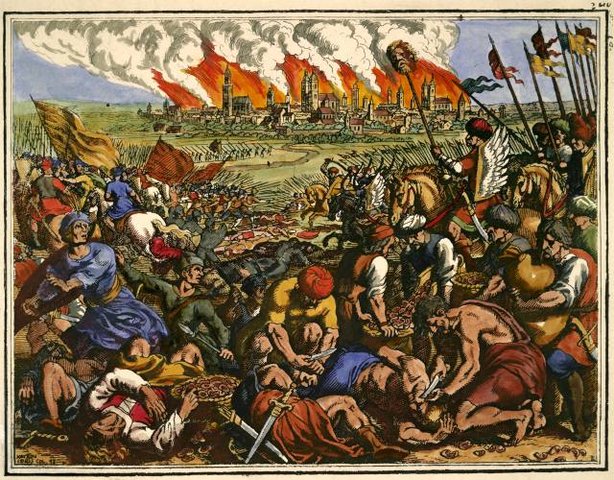The land is flat and vast, extending as far as the eye can see. There is no sun, as such. Rather, an ambient glow with no obvious source permeates. Occupying this Plane is an ocean of people, gathered into groups large and small, distributed irregularly, coalescing and scattering like slow-motion static on a last-century TV.
There are minstrels, artists, trinket-collectors and writers; bards and scientists, astronauts and soldiers. Most huddle together amongst their own kind, but at the periphery a continual jostling and switching takes place. Ideas cross-pollinate and bloom in virgin minds. In the distance a huge throne-topped tower has been erected in honor of a nameless minstrel who has composed a most pleasing melody. Wisdom and culture flows, sways and swirls between and amongst these throngs of sentience.
Alas! The industrious hum of progress is interrupted by a distant rumble. It is the thundering hooves of the Mongol Horde, led by their god, Genghis Khan. A chilled awe descends over the land. Some are so terrified that they subsume themselves into the soil so as to escape what may come. We see a small group of masons huddling in fright as the Horde approaches and - lo! - passes without stopping. It appears that disaster may not visit this day; yet as the final horseman of the Horde rides by, a young mason is knocked to the ground. Before he can check himself, he indignantly rises and issues forth with “U wot m8?!”.
Several pianos stop playing. Children point and gasp. The Mona Lisa’s expression finally resolves into a commiserating frown.
The Horde halts en masse and the Mongols round their horses as one. The other masons curse and spit at the pitiful boy who has already begun to crumple with contrition. “Subsume!” whispers an onlooker. Too late. Shrieking “U WOOOOT!?” in mocking imitation, the Mongols let fly their arrows. The sky is a rushing river of death. The slaughter begins.
Starting with the boy, the Mongols make short work of the masons, and soon move on to the nearby carpenters and sundry other tradesmen. At length, no city-dweller is spared. Their ravenous progress is only halted by the arrival of the god Frederick II at the head of the army of Christendom. In the ensuing melee, everyone must choose a side. Are you with the Khan or with the Christ? WHICH IS IT? Some outwardly peaceful individuals manage to hurriedly work the Mongol creed into their worldview, while others are surprised to discover that a life of atheism has been masking a deep, abiding faith in Jesus. All, however, take up arms; only the failure to do so guarantees an undignified and public slaying. Luckily for those remaining, a wanton assortment of weapons of all kinds spews forth from the soil. The ambient glow of the Plane is temporarily dimmed by the roiling mix of dust and blood.

A depiction of the Battle of Legnica by Matthäus Merian the Elder, painted 1630
An indeterminate amount of time has passed. The battlefield is mostly clear. The tattered corpse of the mason boy hangs from a nearby tree as a handful of Mongol children pelt it with rocks, crying “baddy!” and “devil!” as their parents nod along in approval.
The sky has cleared, and a sense of normalcy is at last returning. But is once again shattered! A lightning bolt strikes the ground by the feet of a Persian merchant. The god Zeus has spoken! Within seconds, a phalanx of Greek hoplites is approaching, spears raised. Most of the surrounding group preemptively subsume themselves into the soil. A frenzied skewering ensues to a chorus of hoplites loudly asserting the superiority of classical Greek culture. Honour served, all that remains is a burgundy-brown sludge where once stood a humble trader of oriental tapestries.
After the hoplites have tired and withdrawn, the merchant’s remaining friends set about scraping the sludge into jars to present to the god Xerxes, who will surely right this great injustice.
Welcome to the Twitterscape.